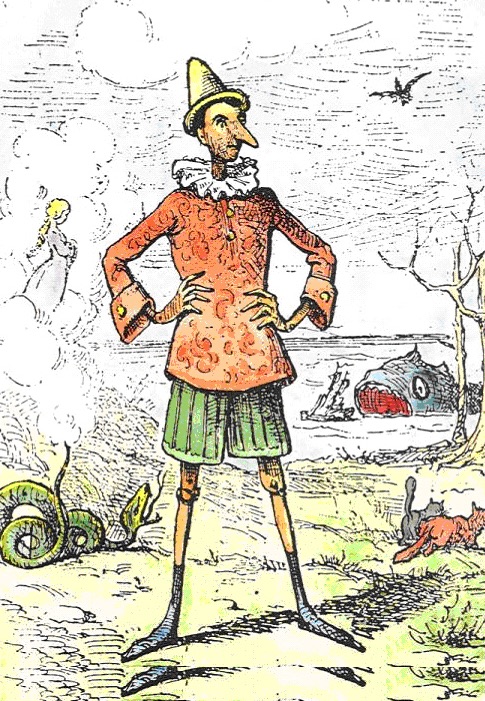
うそ(嘘)
Lie, Mentira

The fictional character Pinocchio is a common depiction of a liar.
☆嘘(うそ, lie)とは、虚偽であると思われる主張の
ことで、通常、誰かを欺いたり、誤解させたりする目的で使われる。
嘘を伝える行為は嘘と呼ばれる。嘘を伝える人は嘘つきと呼ばれることがある。メタファー、誇張表現、その他の比喩的レトリックは誤解を招くことを意図して
いないが、嘘は聴衆による文字通りの解釈を明確に意図している。嘘はまた、それを使用する個人にとって、様々な道具的、対人的、心理的機能を果たすことも
ある。
一般的に、「嘘」という用語は否定的な意味合いを持ち、文脈によっては、嘘を伝えた人が社会的、法的、宗教的、または刑事的制裁を受けることがある。例え
ば、偽証、または宣誓の下で嘘をつくという行為は、偽証者に対して刑事的および民事的な告発がなされることがある。
多くの文化では、欺瞞は非言語的行動(目を合わせない、そわそわする、どもる、微笑むなど)を観察することで発見できると信じられているが、研究による
と、人はそのような手がかりの重要性と、欺瞞について正確な判断を下す能力の両方を過大評価していることが示されている。より一般的に、人が真の判断を下
す能力は、入ってくる情報を受け入れたり、感情を真実の証拠として解釈したりするバイアスに影響される。人は常に、入ってきた主張を自分の記憶と照合する
わけではない。
| A
lie is an assertion that is believed to be false, typically used with
the purpose of deceiving or misleading someone.[1][2][3] The practice
of communicating lies is called lying. A person who communicates a lie
may be termed a liar. Lies can be interpreted as deliberately false
statements or misleading statements, though not all statements that are
literally false are considered lies – metaphors, hyperboles, and other
figurative rhetoric are not intended to mislead, while lies are
explicitly meant for literal interpretation by their audience. Lies may
also serve a variety of instrumental, interpersonal, or psychological
functions for the individuals who use them.[4] Generally, the term "lie" carries a negative connotation, and depending on the context a person who communicates a lie may be subject to social, legal, religious, or criminal sanctions; for instance, perjury, or the act of lying under oath, can result in criminal and civil charges being pressed against the perjurer. Although people in many cultures believe that deception can be detected by observing nonverbal behaviors (e.g. not making eye contact, fidgeting, stuttering, smiling) research indicates that people overestimate both the significance of such cues and their ability to make accurate judgements about deception.[5][6] More generally, people's ability to make true judgments is affected by biases towards accepting incoming information and interpreting feelings as evidence of truth. People do not always check incoming assertions against their memory.[7] |
嘘(うそ)とは、虚偽であると思われる主張のことで、通常、誰かを欺い
たり、誤解させたりする目的で使われる。[1][2][3]
嘘を伝える行為は嘘と呼ばれる。嘘を伝える人は嘘つきと呼ばれることがある。メタファー、誇張表現、その他の比喩的レトリックは誤解を招くことを意図して
いないが、嘘は聴衆による文字通りの解釈を明確に意図している。嘘はまた、それを使用する個人にとって、様々な道具的、対人的、心理的機能を果たすことも
ある[4]。 一般的に、「嘘」という用語は否定的な意味合いを持ち、文脈によっては、嘘を伝えた人が社会的、法的、宗教的、または刑事的制裁を受けることがある。例え ば、偽証、または宣誓の下で嘘をつくという行為は、偽証者に対して刑事的および民事的な告発がなされることがある。 多くの文化では、欺瞞は非言語的行動(目を合わせない、そわそわする、どもる、微笑むなど)を観察することで発見できると信じられているが、研究による と、人はそのような手がかりの重要性と、欺瞞について正確な判断を下す能力の両方を過大評価していることが示されている[5][6]。より一般的に、人が 真の判断を下す能力は、入ってくる情報を受け入れたり、感情を真実の証拠として解釈したりするバイアスに影響される。人は常に、入ってきた主張を自分の記 憶と照合するわけではない[7]。 |
| Types and associated terms 1. A barefaced, bald-faced or bold-faced lie is an impudent, brazen, shameless, flagrant, or audacious lie that is sometimes but not always undisguised and that it is even then not always obvious to those hearing it.[8] 2. A big lie is one that attempts to trick the victim into believing something major, which will likely be contradicted by some information the victim already possesses, or by their common sense. When the lie is of sufficient magnitude it may succeed, due to the victim's reluctance to believe that an untruth on such a grand scale would indeed be concocted.[9] 3. A black lie is about simple and callous selfishness. They are usually told when others gain nothing, and the sole purpose is either to get oneself out of trouble (reducing harm against oneself), or to gain something one desires (increasing benefits for oneself).[10][better source needed] 4. A blue lie is a form of lying that is told purportedly to benefit a collective or "in the name of the collective good". The origin of the term "blue lie" is possibly from cases where police officers made false statements to protect the police force, or to ensure the success of a legal case against an accused.[11] 5. An April fool is a lie or hoax told/performed on April Fools' Day. 6. To bluff is to pretend to have a capability or intention one does not possess.[9] Bluffing is an act of deception that is rarely seen as immoral when it takes place in the context of a game, such as poker, where this kind of deception is consented to in advance by the players. For instance, gamblers who deceive other players into thinking they have different cards to those they really hold, or athletes who hint that they will move left and then dodge right are not considered to be lying (also known as a feint or juke). In these situations, deception is acceptable and is commonly expected as a tactic.[citation needed] 7. Bullshit (also B.S., bullcrap, bull) does not necessarily have to be a complete fabrication. While a lie is related by a speaker who believes what is said is false, bullshit is offered by a speaker who does not care whether what is said is true because the speaker is more concerned with giving the hearer some impression. Thus, bullshit may be either true or false, but demonstrates a lack of concern for the truth that is likely to lead to falsehoods.[12]  A motivational poster about lying declares "An ostrich only thinks he 'covers up'" 8. A cover-up may be used to deny, defend, or obfuscate a lie, errors, embarrassing actions, or lifestyle, and/or lie(s) made previously.[9] One may deny a lie made on a previous occasion, or alternatively, one may claim that a previous lie was not as egregious as it was. For example, to claim that a premeditated lie was really "only" an emergency lie, or to claim that a self-serving lie was really "only" a white lie or noble lie. This should not be confused with confirmation bias in which the deceiver is deceiving themselves.[citation needed] Defamation is the communication of a false statement that harms the reputation of an individual person, business, product, group, government, religion, or nation.[9] To deflect is to avoid the subject that the lie is about, not giving attention to the lie. When attention is given to the subject the lie is based around, deflectors ignore or refuse to respond. Skillful deflectors are passive-aggressive, who when confronted with the subject choose to ignore and not respond.[13] 9. Disinformation is intentionally false or misleading information that is spread in a calculated way to deceive target audiences.[9] 10. An exaggeration occurs when the most fundamental aspects of a statement are true, but only to a certain degree. It also is seen as "stretching the truth" or making something appear more powerful, meaningful, or real than it is. Saying that someone devoured most of something when they only ate half is considered an exaggeration. An exaggeration might be easily found to be a hyperbole where a person's statement (i.e. in informal speech, such as "He did this one million times already!") is meant not to be understood literally.[9] 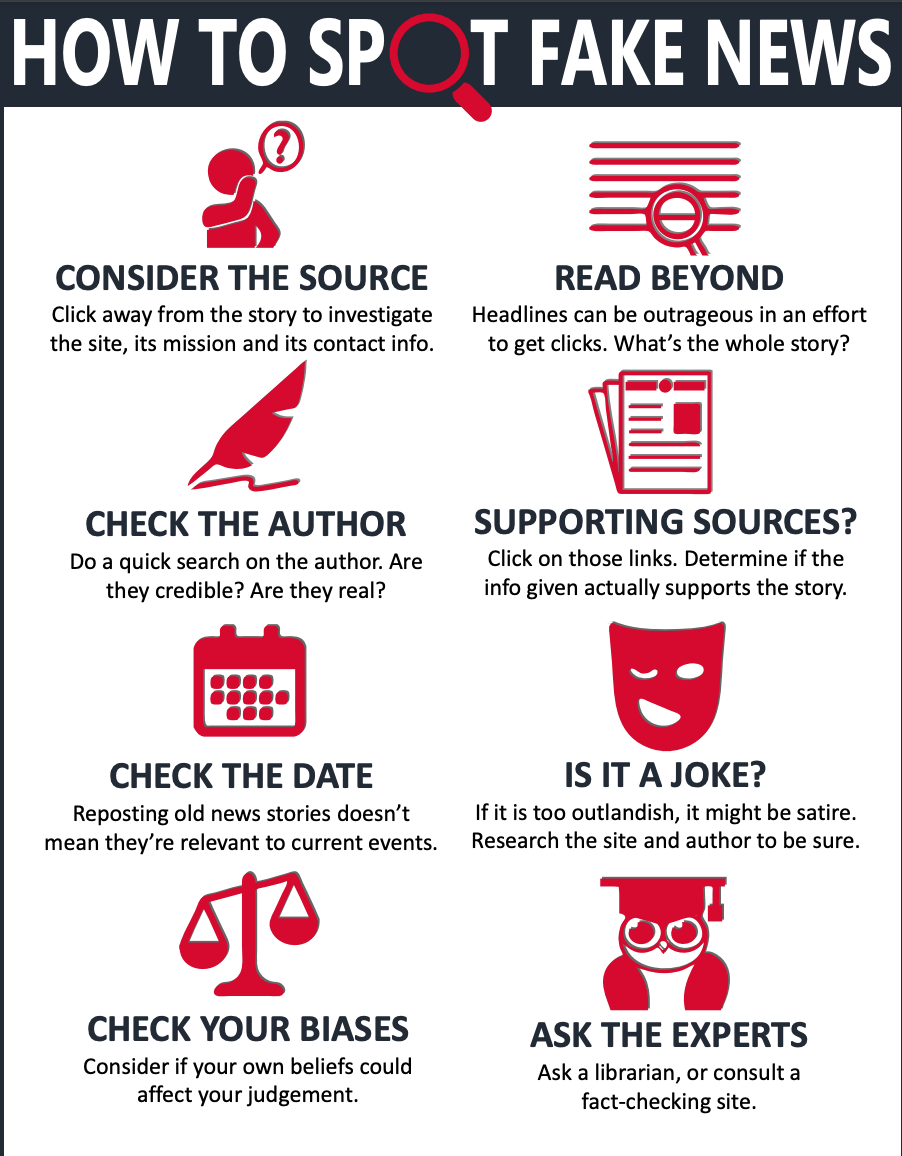 Infographic How to spot fake news published by the International Federation of Library Associations and Institutions 11. Fake news is supposed to be a type of yellow journalism that consists of deliberate misinformation or hoaxes spread via traditional print and broadcast news media or online social media.[14] Sometimes the term is applied as a deceptive device to deflect attention from uncomfortable truths and facts.[citation needed] 12. A fib is a lie that is easy to forgive due to its subject being a trivial matter; for example, a child may tell a fib by claiming that the family dog broke a household vase, when the child was the one who broke it.[9] 13. Fraud refers to the act of inducing another person or people to believe a lie in order to secure material or financial gain for the liar. Depending on the context, fraud may subject the liar to civil or criminal penalties.[15] 14. A gray lie is told partly to help others and partly to help ourselves. It may vary in the shade of gray, depending on the balance of help and harm. Gray lies are, almost by definition, hard to clarify. For example you can lie to help a friend out of trouble but then gain the reciprocal benefit of them lying for you while those they have harmed in some way lose out.[10][better source needed] 15. A half-truth or partial truth is a deceptive statement that includes some element of truth. The statement might be partly true, the statement may be totally true, but only part of the whole truth, or it may employ some deceptive element, such as improper punctuation or double meaning, especially if the intent is to deceive, evade, blame, or misrepresent the truth.[16] Partial truths are characterized by malicious intent, and therefore, honest people should not excuse them as containing a "rational kernel."[17] 16. Confabulation (or honest lie) may be identified by verbal statements or actions that inaccurately describe the history, background, and present situations. There is generally no intent to misinform and the individual is unaware that their information is false. Because of this, it is not technically a lie at all since, by definition, there must be an intent to deceive for the statement to be considered a lie.[citation needed] 17. Jocose lies are lies meant in jest, intended to be understood as such by all present parties. Teasing and irony are examples. A more elaborate instance is seen in some storytelling traditions, where the storyteller's insistence that the story is the absolute truth, despite all evidence to the contrary (i.e., tall tale), is considered humorous. There is debate about whether these are "real" lies, and different philosophers hold different views. The Crick Crack Club in London arranges a yearly "Grand Lying Contest" with the winner being awarded the coveted "Hodja Cup" (named for the Mulla Nasreddin: "The truth is something I have never spoken."). The winner in 2010 was Hugh Lupton. In the United States, the Burlington Liars' Club awards an annual title to the "World Champion Liar."[18] 18. Lie-to-children is a phrase that describes a simplified explanation of technical or complex subjects as a teaching method for children and laypeople. While lies-to-children are useful in teaching complex subjects to people who are new to the concepts discussed, they can promote the creation of misconceptions among the people who listen to them. The phrase has been incorporated by academics within the fields of biology, evolution, bioinformatics, and the social sciences. Media use of the term has extended to publications including The Conversation and Forbes.[citation needed] 19. Lying by omission, also known as a continuing misrepresentation or quote mining, occurs when an important fact is left out in order to foster a misconception. Lying by omission includes the failure to correct pre-existing misconceptions. For example, when the seller of a car declares it has been serviced regularly, but does not mention that a fault was reported during the last service, the seller lies by omission. It may be compared to dissimulation. An omission is when a person tells most of the truth, but leaves out a few key facts that therefore, completely obscures the truth.[13] 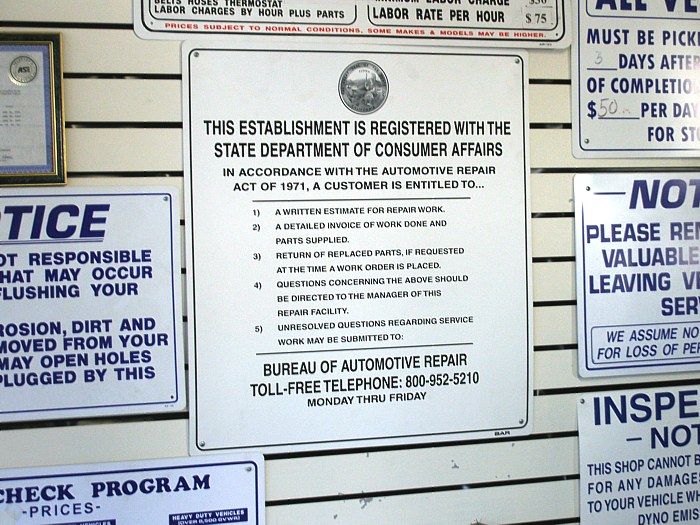 Consumer protection laws often mandate the posting of notices, such as this one which appears in all automotive repair shops in California. 20. Lying in trade occurs when the seller of a product or service may advertise untrue facts about the product or service in order to gain sales, especially by competitive advantage. Many countries and states have enacted consumer protection laws intended to combat such fraud. 21. A memory hole is a mechanism for the alteration or disappearance of inconvenient or embarrassing documents, photographs, transcripts, or other records, such as from a website or other archive, particularly as part of an attempt to give the impression that something never happened.[19][20] 22. Minimization is the opposite of exaggeration. It is a type of deception[21] involving denial coupled with rationalization in situations where complete denial is implausible.[citation needed] 23. Mutual deceit is a situation wherein lying is both accepted and expected[22] or that the parties mutually accept the deceit in question. This can be demonstrated in the case of a poker game wherein the strategies rely on deception and bluffing to win.[23] 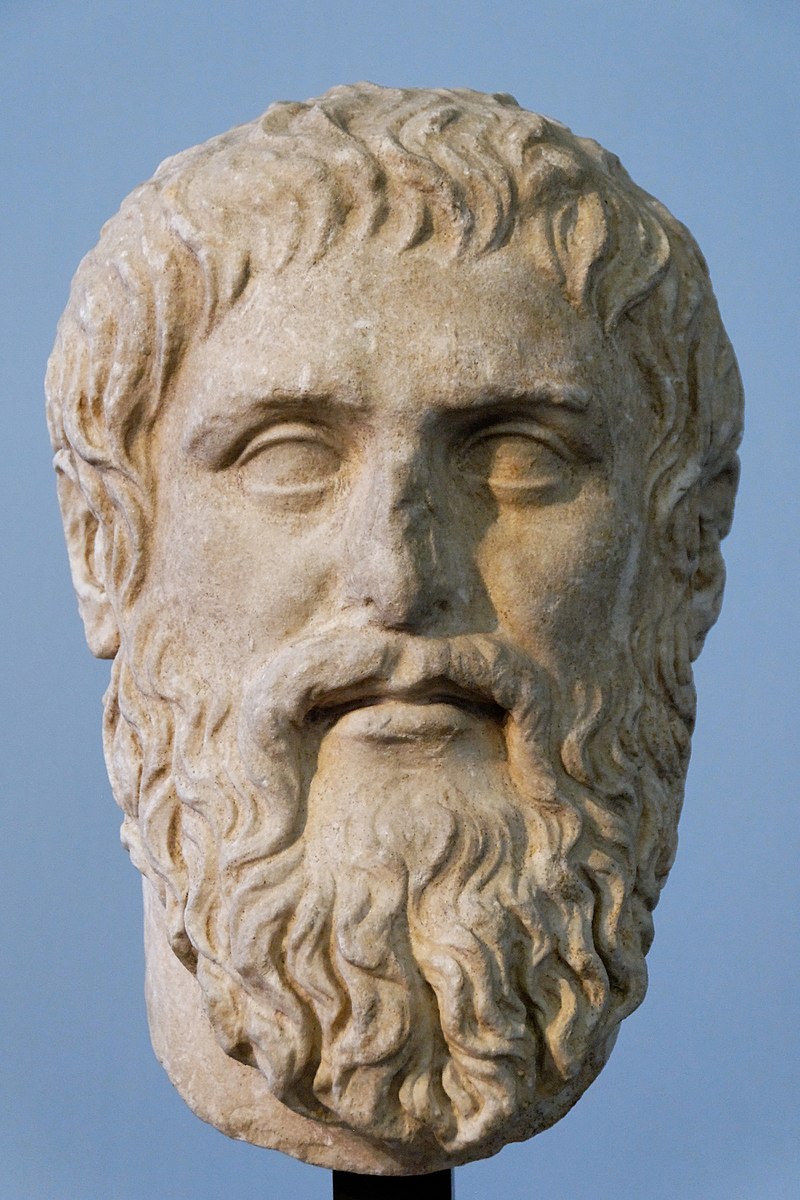 Plato presented arguments to justify the use of noble lies in his Republic.[24] 24. A noble lie, which also could be called a strategic untruth, is one that normally would cause discord if uncovered, but offers some benefit to the liar and assists in an orderly society, therefore, potentially being beneficial to others. It is often told to maintain law, order, and safety. 25. Paltering is the active use of selective truthful statements to mislead.[25] 26. Paternalistic deception is a lie told because it is believed (possibly incorrectly) that the deceived person will benefit. 27. In psychiatry, pathological lying (also called compulsive lying, pseudologia fantastica, and mythomania) is a behavior of habitual or compulsive lying.[26][27] It was first described in the medical literature in 1891 by Anton Delbrueck.[27] Although it is a controversial topic,[27] pathological lying has been defined as "falsification entirely disproportionate to any discernible end in view, may be extensive and very complicated, and may manifest over a period of years or even a lifetime".[26] The individual may be aware they are lying, or may believe they are telling the truth, being unaware that they are relating fantasies.[citation needed] 28. Perjury is the act of lying or making verifiably false statements on a material matter under oath or affirmation in court, or in any of various sworn statements in writing. Perjury is a crime, because the witness has sworn to tell the truth, and for the credibility of the court to remain intact, witness testimony must be relied on as truthful.[9] 29. A polite lie is a lie that a politeness standard requires, and that usually is known to be untrue by both parties. Whether such lies are acceptable is heavily dependent on culture. A common polite lie in international etiquette may be to decline invitations because of "scheduling difficulties", or due to "diplomatic illness". Similarly, the butler lie is a small lie that usually is sent electronically and is used to terminate conversations or to save face.[28] 30. Puffery is an exaggerated claim typically found in advertising and publicity announcements, such as "the highest quality at the lowest price", or "always votes in the best interest of all the people". Such statements are unlikely to be true – but cannot be proven false and so, do not violate trade laws, especially as the consumer is expected to be able to determine that it is not the absolute truth.[29] 31. A red lie is about spite and revenge. It is driven by the motive to harm others even at the expense of harming oneself, out of an angry desire for retribution.[10][better source needed] 32. The phrase "speaking with a forked tongue" means to deliberately say one thing and mean another or, to be hypocritical, or act in a duplicitous manner. This phrase was adopted by Americans around the time of the Revolution, and may be found in abundant references from the early nineteenth century – often reporting on American officers who sought to convince the Indigenous peoples of the Americas with whom they negotiated that they "spoke with a straight and not with a forked tongue" (as for example, President Andrew Jackson told members of the Creek Nation in 1829).[30] According to one 1859 account, the proverb that the "white man spoke with a forked tongue" originated in the 1690s, in the descriptions by the indigenous peoples of French colonials in America inviting members of the Iroquois Confederacy to attend a peace conference, but when the Iroquois arrived, the French had set an ambush and proceeded to slaughter and capture the Iroquois.[31] 33. A theraputic fib is lying, or bending the truth, in order to avoid increased agitation from a person with dementia.[32] The intent is not to deceive the patient, but rather to help them feel safe and secure in facing an otherwise upsetting situation or fact. 34. Weasel word is an informal term[33] for words and phrases aimed at creating an impression that a specific or meaningful statement has been made, when in fact only a vague or ambiguous claim has been communicated, enabling the specific meaning to be denied if the statement is challenged. A more formal term is equivocation.[citation needed] A white lie is a harmless or trivial lie, especially one told in order to be polite or to avoid hurting someone's feelings or stopping them from being upset by the truth.[34][35][36] A white lie also is considered a lie to be used for greater good (pro-social behavior). It sometimes is used to shield someone from a hurtful or emotionally-damaging truth, especially when not knowing the truth is deemed by the liar as completely harmless. However, white lies can still be harmful as they can foster distrust when used in inappropriate situations.[37] 35. Vranyo expresses white lies or half-lies in Russian culture, told without the intention of (maliciously) deceiving, but as a fantasy, suppressing unpleasant parts of the truth.[citation needed] |
種類と関連用語 1. 素顔の嘘、はげしい嘘、大胆な嘘とは、不謹慎な嘘、図々しい嘘、恥知らずな嘘、あからさまな嘘、大胆な嘘のことである。 2. 大きな嘘とは、被害者を騙して何か重大なことを信じ込ませようとするもので、被害者がすでに持っている情報や常識によって矛盾する可能性が高い。その嘘が 十分な規模のものである場合、被害者がそのような壮大な規模の不真実が本当にでっち上げられたと信じようとしないため、成功することがある[9]。 3. 黒い嘘とは、単純で無慈悲な利己主義に関するものである。通常、他人が何も得をしないときにつくものであり、唯一の目的は、自分自身をトラブルから救う (自分に対する危害を減らす)か、自分が望む何かを得る(自分にとっての利益を増やす)ことである[10][要出典]。 4. 青い嘘とは、集団の利益のため、あるいは「集団の利益の名において」と称してつく嘘の一形態である。青い嘘」という言葉の語源は、警察官が警察組織を守る ため、あるいは被告人に対する裁判を確実に成功させるために虚偽の供述をした事例からきている可能性がある[11]。 5. エイプリル・フール(April fool)とは、エイプリルフールについた嘘やデマのことである。 6. ブラフとは、自分が持っていない能力や意図を持っているふりをすることである[9]。ブラフは、ポーカーのような、この種の欺瞞がプレイヤーによって事前 に同意されているゲームの文脈で行われる場合には、不道徳とみなされることはほとんどない欺瞞行為である。例えば、ギャンブラーが他のプレイヤーを欺い て、自分が本当に持っているカードと違うカードを持っていると思わせたり、スポーツ選手が左に動くことをほのめかして右にかわすことは、嘘をついていると はみなされない(フェイントやジュークとも呼ばれる)。このような状況では、ごまかしは容認され、戦術として一般的に期待されている[要出典]。 7. でたらめ(B.S.、bullcrap、bullとも)は必ずしも完全なでっち上げである必要はない。嘘は、言ったことが嘘だと信じている話し手がつくも のであるが、でたらめは、話し手が聞き手に何らかの印象を与えることに関心があるため、言ったことが真実かどうかを気にしない話し手がつくものである。し たがって、デタラメは真実であっても嘘であってもよいが、虚偽につながりやすい真実に対する関心の欠如を示している[12]。  嘘をつく動機付けとなるポスターは、「ダチョウは自分が 「隠蔽 」しているとしか思っていない」と宣言している。 8. 隠蔽は、嘘、誤り、恥ずべき行為、生活習慣、および/または以前についた嘘を否定、擁護、または難読化するために使われることがある[9]。例えば、計画 的な嘘は本当は緊急の嘘「だけ」だったと主張したり、利己的な嘘は本当は白い嘘や高貴な嘘「だけ」だったと主張したりする。これは、騙す側が自分自身を騙 しているという確証バイアスと混同してはならない[要出典]。 ナショナリズムとは、個人、企業、製品、団体、政府、宗教、国民などの評判を傷つける虚偽の発言を伝えることである[9]。 話をそらすとは、その嘘の対象を避け、嘘に注意を向けないことである。嘘の主題に注意が向けられると、話をそらす人は無視するか、返事を拒否する。巧みな偏向者は受動的攻撃的であり、その主題に直面したとき、無視し反応しないことを選択する[13]。 9. 偽情報とは、意図的に虚偽の、あるいは誤解を招くような情報であり、対象となる聴衆を欺くために計算された方法で流布される[9]。 10. 誇張とは、ある発言の最も基本的な側面が真実であるが、ある程度までしか真実でない場合に起こる。また、「真実を引き延ばす」、あるいは何かを実際よりも 強力に、有意義に、あるいは現実に見せることとも見なされる。半分しか食べていないのに、ほとんど食べてしまったというのは誇張とみなされる。誇張は、人 の発言(すなわち、「彼はすでに100万回これをやった!」のような非公式なスピーチで)が文字通りに理解されないことを意味する誇張表現であることが容 易に発見されるかもしれない[9]。  インフォグラフィック 国際図書館協会連合が発表したフェイクニュースの見分け方 11. フェイクニュースとは、イエロージャーナリズムの一種であるとされ、伝統的な印刷物や放送のニュースメディア、あるいはオンラインのソーシャルメディアを 通じて拡散される意図的な誤報やデマで構成されている[14]。この用語は、不快な真実や事実から注意をそらすための欺瞞的な装置として適用されることも ある[要出典]。 12. 例えば、家庭用の花瓶を割ったのは子供であるにもかかわらず、子供が「家の犬が花瓶を割った」と主張することで嘘をつくことがある[9]。 13. 詐欺とは、嘘をついた人の物質的または金銭的な利益を確保するために、他者や人々に嘘を信じ込ませる行為を指す。文脈によっては、詐欺は嘘つきに民事罰や刑事罰を科すことがある[15]。 14. 灰色の嘘は、一部は他人を助けるために、一部は自分自身を助けるためにつく。助けることと傷つけることのバランスによって、グレーの濃淡が変わることがあ る。灰色の嘘は、ほとんど定義上、明確にするのが難しい。例えば、友人をトラブルから助けるために嘘をつくことができるが、友人があなたのために嘘をつく という互恵的な利益を得る一方で、友人が何らかの形で害を与えた人は損をする[10][better source needed]。 15. 半真実または部分的真実は、真実の要素を含む欺瞞的な発言である。その陳述は部分的に真実であるかもしれないし、陳述は完全に真実であるかもしれないが、真実全体の一部だけであるかもしれないし、不適切な句読点や二重の意味などの欺瞞的要素を用いるかもしれない。 16. 混同(または正直な嘘)は、歴史、背景、現在の状況を不正確に説明する言動によって識別されることがある。一般に誤報の意図主義はなく、本人は自分の情報 が虚偽であることに気づいていない。このため、定義上、その発言が嘘とみなされるためには欺く意図がなければならないため、厳密には全く嘘とは言えない [要出典]。 17. 冗談のような嘘とは、その場にいるすべての関係者がそのように理解することを意図した、冗談のつもりでついた嘘のことである。からかいや皮肉がその例であ る。もっと手の込んだ例としては、物語を語る伝統の中で、物語が絶対的な真実であるという語り手の主張が、それに反するあらゆる証拠(すなわち、背の高い 話)にもかかわらず、ユーモラスであるとみなされるものがある。これらが「本当の」嘘かどうかについては議論があり、哲学者によって見解が異なる。ロンド ンのクリック・クラック・クラブは毎年「大嘘つきコンテスト」を開催しており、優勝者には栄誉ある「ホジャ杯」(ムッラ・ナスレッディンにちなんで名付け られた。) 2010年の優勝者はヒュー・ラプトンだった。アメリカでは、バーリントン・ライヤーズ・クラブが毎年「世界チャンピオン・ライアー」の称号を授与してい る[18]。 18. Lie-to-childrenとは、子供や一般人向けの教育方法として、専門的あるいは複雑なテーマを簡略化して説明することを表す言葉である。嘘から 子どもへ」は、複雑なテーマについて、その概念を初めて知る人に教えるには有効だが、それを聞く人の間に誤解を生むことを助長する可能性がある。この言葉 は、生物学、進化学、バイオインフォマティクス、社会科学の分野の学者によって取り入れられてきた。メディアによるこの言葉の使用は、『The Conversation』や『Forbes』などの出版物にも及んでいる[要出典]。 19. 省略による嘘は、継続的な虚偽表示または引用マイニングとしても知られ、誤解を助長するために重要な事実が省かれる場合に発生する。不作為による嘘には、 既存の誤解を正さないことも含まれる。例えば、車の売り手が定期的に点検を受けていると宣言しているにもかかわらず、前回の点検で故障が報告されたことに 触れない場合、売り手は不作為による嘘をつくことになる。これは虚偽に例えられるかもしれない。省略とは、人が真実の大部分を語るが、いくつかの重要な事 実を省くことであり、そのため真実が完全に不明瞭になることである[13]。  消費者保護法は、カリフォルニア州のすべての自動車修理工場に掲示されているこの通知のような掲示を義務付けていることが多い。 20. 取引における嘘は、製品やサービスの販売者が、特に競争上の優位性によって売上を獲得するために、製品やサービスに関して真実でない事実を宣伝する場合に発生する。多くの国や州が、このような詐欺行為に対抗することを目的とした消費者保護法を制定している。 21. メモリーホール(memory hole)とは、都合の悪い、あるいは恥ずべき文書、写真、記録、その他の記録、例えばウェブサイトやその他のアーカイブから、特に何かが起こらなかった かのような印象を与えようとする試みの一環として、改ざんまたは消失させる仕組みのことである[19][20]。 22. 最小化は誇張の反対である。完全な否定があり得ない状況において、合理化と結びついた否定を含む欺瞞[21]の一種である[要出典]。 23. 相互欺瞞とは、嘘をつくことが受け入れられ期待されている[22]、あるいは当事者が問題の欺瞞を相互に受け入れている状況である。これは、勝つための戦略が欺瞞とブラフに依存しているポーカーゲームの場合に示すことができる[23]。  プラトンは『共和国』において、高貴な嘘の使用を正当化する論拠を示した[24]。 24. 高貴な嘘とは、戦略的な真実でない嘘とも呼ばれ、通常であれば発覚すれば不和を引き起こすが、嘘をつく者に何らかの利益をもたらし、秩序ある社会を助けるものである。法、秩序、安全を維持するためにしばしば語られる。 25. パータリングとは、誤解を招くために、選択的に真実の発言を積極的に用いることである[25]。 26. パターナリスティックな欺瞞とは、欺かれた人が利益を得ると(おそらく間違って)信じられているためにつく嘘のことである。 27. 精神医学において、病的な嘘(強迫的嘘、空想的仮像、神話マニアとも呼ばれる)は、習慣的または強迫的な嘘の行動である[26][27]。 [病的な嘘は、「視野にあるいかなる識別可能な目的にも完全に不釣り合いな改ざんであり、広範かつ非常に複雑である可能性があり、数年間または生涯にわ たって現れる可能性がある」と定義されている。 28. 偽証とは、法廷での宣誓や確約、あるいは書面による様々な宣誓陳述において、重要な事柄について嘘をついたり、証明可能なほど虚偽の陳述をしたりすること である。偽証は犯罪であるが、それは証人が真実を述べると誓ったからであり、法廷の信頼性を維持するためには、証人の証言が真実であると信頼されなければ ならないからである[9]。 29. 丁寧な嘘とは、礼儀正しさの基準が要求する嘘であり、通常、当事者双方が真実でないと知っている嘘である。このような嘘が受け入れられるかどうかは文化に 大きく依存する。国際的なエチケットにおいて一般的な丁寧な嘘は、「日程調整が難しい」あるいは「外交官の病気」を理由に招待を断ることであろう。同様 に、執事の嘘は、通常電子的に送信される小さな嘘であり、会話を打ち切ったり、面目を保つために使われる[28]。 30. 誇大広告とは、広告や宣伝のアナウンスによく見られる誇張された主張のことで、「最高の品質を最低の価格で」とか、「常にすべての国民の利益のために投票 する」などといったものである。このような記述は真実である可能性は低いが、虚偽であることを証明することはできないため、特に消費者はそれが絶対的な真 実ではないことを判断できると予想されるため、取引法に違反することはない[29]。 31. 赤い嘘とは、恨みと復讐のためのものである。怒りに満ちた報復の欲求から、自分を犠牲にしてでも他人を傷つけようとする動機によって引き起こされる[10][要出典]。 32. 分かれ目の舌で話す」とは、あることを意図的に言って別のことを意味すること、あるいは偽善的であること、二枚舌で行動することを意味する。このフレーズ は独立革命の頃にアメリカ人によって採用されたもので、19世紀初頭の豊富な文献の中に見出すことができる。多くの場合、アメリカ人将校が交渉の相手であ るアメリカ大陸の先住民に対して、自分たちは「分かれ目のある舌ではなく、まっすぐな舌で話している」(例えば、アンドリュー・ジャクソン大統領が 1829年にクリーク民族のメンバーに語ったように)と説得しようとしたことが報告されている。 [30] 1859年のある記述によれば、「白人は叉のある舌で話す」という諺は1690年代、アメリカのフランス植民地がイロコイ族連合のメンバーを和平会議に招 待したが、イロコイ族が到着したときにはフランスは待ち伏せをしており、イロコイ族を虐殺し捕らえようとしたという先住民の記述に由来している[31]。 33. 意図主義は患者を欺くことではなく、むしろ患者が動揺するような状況や事実に直面しても安心し、安全だと感じられるようにすることである[32]。 34. イタチごっこ(Weasel word)とは、非公式な用語[33]であり、実際には漠然とした、あるいは曖昧な主張しか伝えられていないにもかかわらず、特定の、あるいは意味のある 発言がなされたかのような印象を与えることを目的とした語句のことである。より正式な用語はequivocationである[要出典]。 白い嘘とは、無害な、あるいは些細な嘘のことで、特に礼儀正しくするためや、誰かの感情を傷つけないため、あるいは真実によって動揺するのを止めるために つく嘘のことである[34][35][36]。白い嘘はまた、より大きな善(親社会的行動)のために使われる嘘とも考えられている。誰かを傷つけたり、感 情を害したりする真実から身を守るために使われることもあり、特に真実を知らないことが、嘘をつく本人にとって全く無害であるとみなされる場合に使われ る。しかし、白い嘘は不適切な状況で使われると不信感を助長するため、依然として有害である可能性がある[37]。 35. ヴラーニョはロシア文化における白い嘘や半分の嘘を表現しており、(意図主義的に)欺くことなく、空想として、真実の不快な部分を抑圧して語られる[要出典]。 |
| Consequences The potential consequences of lying are manifold; some in particular are worth considering. Typically lies aim to deceive, so the hearer may acquire a false belief (or at least something that the speaker believes to be false). When deception is unsuccessful, a lie may be discovered. The discovery of a lie may discredit other statements by the same speaker, thereby staining that speaker's reputation. In some circumstances, it may also negatively affect the social or legal standing of the speaker. Lying in a court of law, for instance, is a criminal offense (perjury).[38] Hannah Arendt spoke about extraordinary cases in which an entire society is being lied to consistently. She said that the consequences of such lying are "not that you believe the lies, but rather that nobody believes anything any longer. This is because lies, by their very nature, have to be changed, and a lying government has constantly to rewrite its own history. On the receiving end you get not only one lie – a lie which you could go on for the rest of your days – but you get a great number of lies, depending on how the political wind blows."[39] |
結果 嘘をつくことの潜在的な結果は多岐にわたるが、特に考慮する価値のあるも のがいくつかある。一般的に、嘘は人を欺くことを目的としているため、聞き手は偽りの信 念(または、少なくとも話し手が偽りだと信じているもの)を身につけるかもし れない。欺くことに失敗すると、嘘が発覚することがある。嘘が発覚すると、同じ話し手による他の発言の信用を失い、その話し手の評判を落とすことになる。 状況によっては、発言者の社会的または法的地位に悪影響を及ぼすこともある。例えば、法廷での嘘は犯罪行為(偽証罪)である[38]。 ハンナ・アーレントは、社会全体が一貫して嘘をつかれているような異常な場合について語った。彼女は、そのような嘘の結末は「嘘を信じることではなく、も はや誰も何も信じなくなること」だと述べた。なぜなら、嘘はその性質上、変えなければならないからであり、嘘をつく政府は常に自らの歴史を書き換えなけれ ばならない。嘘の受け手側には、ひとつの嘘、つまり一生つき続けることのできる嘘だけでなく、政治的な風の吹き方によって、数多くの嘘が吹き荒れることに なる」[39]。 |
| Detection Main article: Lie detection The question of whether lies can be detected reliably through nonverbal has been the subject of frequent study. While people in many cultures believe that deception can be indicated by behaviors such as looking away, fidgeting, or stammering, this is not supported by research.[5][6] A 2019 review of research on deception and its detection through nonverbal behavior concludes that people tend to overestimate both the reliability of nonverbal behavior as an indicator of deception, and their ability to make accurate judgements about deception based on nonverbal behavior.[5][40] Polygraph "lie detector" machines measure the physiological stress a subject endures in a number of measures while giving statements or answering questions. Spikes in stress indicators are purported to reveal lying. The accuracy of this method is widely disputed. In several well-known cases, application of the technique has been shown to have given incorrect results.[examples needed] Nonetheless, it remains in use in many areas, primarily as a method for eliciting confessions or employment screening. The unreliability of polygraph results is the basis of the exclusion of such evaluations as admissible evidence in many courts, and the technique is generally perceived to be an example of pseudoscience.[41] A recent study found that composing a lie takes longer than telling the truth and thus, the time taken to answer a question may be used as a method of lie detection.[42] Instant answers with a lie may be proof of a prepared lie. A recommendation provided to resolve that contradiction is to try to surprise the subject and find a midway answer, not too quick, nor too long.[43] |
検出 主な記事 嘘の発見 非言語によって嘘を確実に見抜くことができるかという疑問は、これまで頻繁に研究されてきた。多くの文化圏の人々は、目をそらす、そわそわする、どもるな どの行動によって欺瞞を示すことができると信じているが、これは研究によって裏付けられていない[5][6]。非言語行動による欺瞞とその発見に関する研 究の2019年のレビューでは、人々は欺瞞の指標としての非言語行動の信頼性と、非言語行動に基づいて欺瞞について正確な判断を下す能力の両方を過大評価 する傾向があると結論づけている[5][40]。 ポリグラフ 「嘘発見器 」は、被験者が供述をしたり質問に答えたりしている間に耐える生理的ストレスを多くの尺度で測定する。ストレス指標のスパイクは嘘を明らかにするとされ る。この方法の正確性については広く議論がある。いくつかの有名な事例では、この手法を適用した結果、正しくない結果が得られたことが示されている[要出 典]。それにもかかわらず、ポリグラフは、主に自白を引き出したり、採用選考を行ったりする方法として、多くの分野で使用されている。ポリグラフの結果の 信頼性の低さは、多くの裁判所においてそのような評価を証拠採用の対象から除外する根拠となっており、この技術は一般的に疑似科学の一例であると認識され ている[41]。 最近の研究によると、嘘を構成するには真実を話すよりも時間がかかるため、質問に答えるのにかかる時間が嘘発見の方法として使用される可能性がある [42]。この矛盾を解決するために提示された推奨は、被験者を驚かせようとし、早すぎず長すぎない中間の答えを見つけることである[43]。 |
| Ethics See also: Christian views on lying 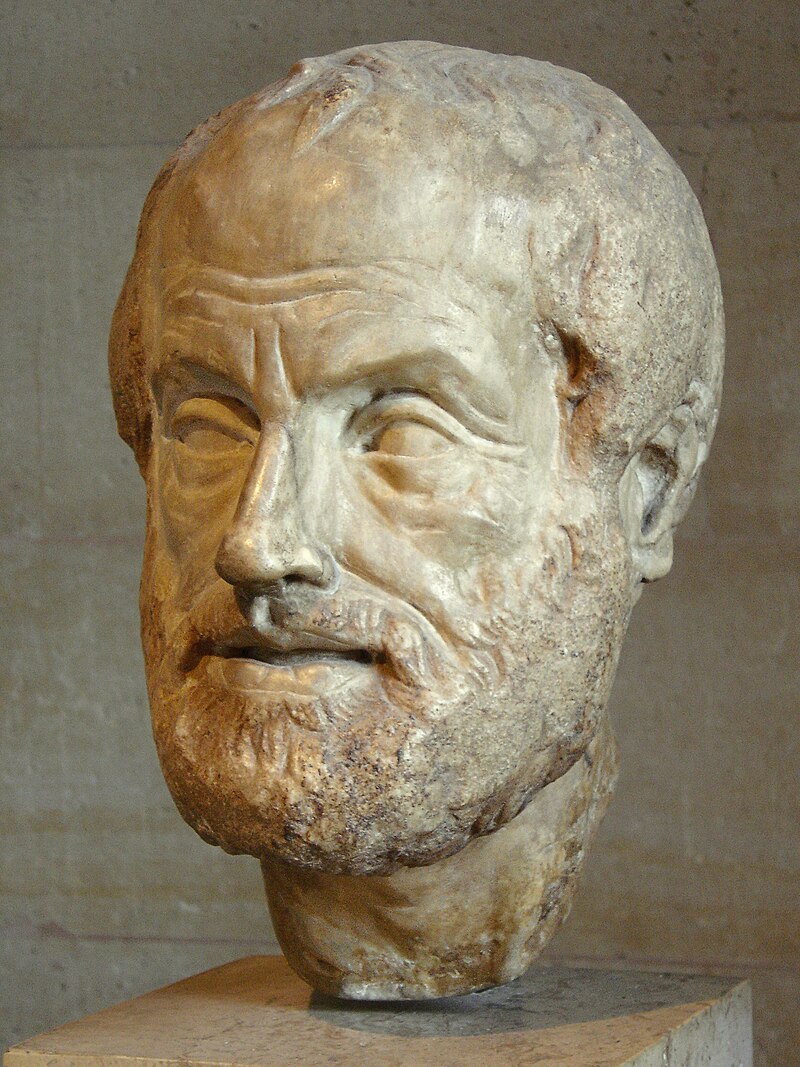 Portrait bust of Aristotle made by Lysippos Utilitarian philosophers have supported lies that achieve good outcomes – white lies.[44] In his 2008 book, How to Make Good Decisions and Be Right All the Time, Iain King suggested a credible rule on lying was possible, and he defined it as: "Deceive only if you can change behaviour in a way worth more than the trust you would lose, were the deception discovered (whether the deception actually is exposed or not)."[45] Stanford law professor Deborah L. Rhode articulated three rules she says ethicists generally agree distinguish "white lies" from harmful lies or cheating:[46] A disinterested observer would conclude that the benefits outweigh the harms There is no alternative If everyone in similar circumstances acted similarly, society would be no worse off Aristotle believed no general rule on lying was possible, because anyone who advocated lying could never be believed, he said.[47] The philosophers St. Augustine, St. Thomas Aquinas, and Immanuel Kant, condemned all lying.[44] According to all three, there are no circumstances in which, ethically, one may lie. Even if the only way to protect oneself is to lie, it is never ethically permissible to lie even in the face of murder, torture, or any other hardship. Each of these philosophers gave several arguments for the ethical basis against lying, all compatible with each other. Among the more important arguments are: Lying is a perversion of the natural faculty of speech, the natural end of which is to communicate the thoughts of the speaker. When one lies, one undermines trust in society. In Lying, neuroscientist Sam Harris argues that lying is negative for the liar and the person who is being lied to. To tell lies is to deny others access to reality, and the harm of lying often cannot be anticipated. The ones lied to may fail to solve problems they could have solved only on a basis of good information. To lie also harms oneself, making the liar distrust the person who is being lied to.[48] Liars generally feel badly about their lies and sense a loss of sincerity, authenticity, and integrity. Harris asserts that honesty allows one to have deeper relationships and to bring all dysfunction in one's life to the surface. In Human, All Too Human, philosopher Friedrich Nietzsche suggested that those who refrain from lying may do so only because of the difficulty involved in maintaining lies. This is consistent with his general philosophy that divides (or ranks) people according to strength and ability; thus, some people tell the truth only out of weakness. A study was conducted by the University of Nottingham, released in 2016, which utilized a dice roll test where participants could easily lie to get a bigger payout. The study found that in countries with high prevalence of rule breaking, dishonesty in people in their early 20s was more prevalent.[49] |
倫理 こちらも参照のこと: キリスト教の嘘観  リュシッポスによるアリストテレスの胸像 功利主義的な哲学者たちは、良い結果をもたらす嘘、つまり「白い嘘」を支持してきた[44]。2008年に出版された著書『How to Make Good Decisions and Be Right All the Time』において、イアン・キングは嘘に関する信頼できるルールが可能であることを示唆し、それを次のように定義した: 「欺瞞が発覚した場合(実際に欺瞞が露見したかどうかは別として)、失うであろう信頼よりも価値のある方法で行動を変えられる場合にのみ、欺くこと」 [45]。 スタンフォード大学の法学教授デボラL.ロードは、倫理学者が一般的に同意する「白い嘘」と有害な嘘や不正行為を区別する3つのルールを明示している[46]。 利害関係のない観察者は、利益が害を上回ると結論づけるだろう。 代替手段がない 同じような境遇にあるすべての人が同じように行動しても、社会が悪くなることはない アリストテレスは、嘘をつくことを提唱する者は決して信じてもらえないので、嘘に関する一般的なルールはあり得ないと考えていた[47]。哲学者の聖アウ グスティヌス、聖トマス・アクィナス、イマヌエル・カントは、すべての嘘を非難した[44]。この3人によれば、倫理的に嘘をついてよい状況は存在しな い。たとえ自分を守る唯一の方法が嘘をつくことであったとしても、殺人や拷問、その他の苦難に直面しても、嘘をつくことは倫理的に決して許されない。これ らの哲学者はそれぞれ、嘘をつくことに対する倫理的根拠についていくつかの論拠を示し、それらはすべて互いに両立しうるものであった。中でも重要な論拠は 以下の通りである: 嘘をつくことは、「話し手の考えを伝えるという自然な目的である自然な言語能力」を曲解することである。 嘘をつくと、社会的信用が損なわれる。 神経科学者のサム・ハリスは『嘘をつくこと』の中で、嘘をつくことは嘘をつく人にとっても嘘をつかれる人にとってもマイナスであると主張している。嘘をつ くということは、他人が現実にアクセスすることを否定することであり、嘘をつくことの害はしばしば予測できない。嘘をつかれた人は、正しい情報に基づいて のみ解決できたはずの問題を解決できないかもしれない。嘘をつくことは自分自身にも害を及ぼし、嘘をつかれている人に不信感を抱かせる。ハリスは、正直で あることで、より深い人間関係を築くことができ、自分の人生におけるすべての機能不全を表面に出すことができると主張する。 哲学者フリードリヒ・ニーチェは、『人間、あまりにも人間的なもの』の中で、嘘をつくことを控える人は、嘘をつき続けることが難しいからそうしているだけ かもしれないと示唆している。これは、強さや能力によって人を分ける(ランク付けする)という彼の一般的な哲学と一致している。 2016年に発表されたノッティンガム大学による研究では、参加者がより大きな配当を得るために簡単に嘘をつくことができるサイコロを使ったテストが行われた。この研究では、ルール違反が多い国では、20代前半の人の不誠実さが目立つことがわかった[49]。 |
| Great apes and mother birds Possession of the capacity to lie among non-humans has been asserted during language studies with great apes. In one instance, the gorilla Koko, when asked who tore a sink from the wall, pointed to one of her handlers and then laughed.[50] Deceptive body language, such as feints that mislead as to the intended direction of attack or flight, is observed in many species. A mother bird deceives when she pretends to have a broken wing to divert the attention of a perceived predator – including unwitting humans – from the eggs in her nest, instead to her, as she draws the predator away from the location of the nest, most notably a trait of the killdeer.[51] |
類人猿と母鳥 人間以外の動物が嘘をつく能力を持っていることは、類人猿を使った言語研究でも証明されている。ある例では、ゴリラのココが、壁から流し台を引きちぎったのは誰かという質問に対して、ハンドラーの一人を指差して笑った[50]。 攻撃や飛行の方向を誤認させるフェイントのような欺瞞的なボディランゲージは、多くの種で観察される。母鳥が翼が折れたふりをするのは、捕食者(無意識の人間を含む)の注意を巣の卵からそらすためである。 |
Cultural references Drawing of a puppet with a long nose Pinocchio, a symbol of untruthfulness Carlo Collodi's Pinocchio is a wooden puppet character often led into trouble by his propensity to lie; his nose grows with every one. Hence, long noses have become a caricature of liars. The Boy Who Cried Wolf, a fable attributed to Aesop about a boy who continually lies that a wolf is coming. When a wolf does appear, nobody believes him anymore. A famous anecdote by Parson Weems claims that George Washington once cut at a cherry tree with a hatchet when he was a small child. His father asked him who cut the cherry tree and Washington confessed his crime with the words: "I'm sorry, father, I cannot tell a lie." To Tell the Truth was the originator of a genre of game shows with three contestants claiming to be a person only one of them is. Glenn Kessler, a journalist at The Washington Post, awards one to four Pinocchios to politicians in his Washington Post Fact Checker blog.[52] The cliché "All is fair in love and war",[53][54] asserts justification for lies used to gain advantage in these situations. Sun Tzu declared that "All warfare is based on deception." Machiavelli advised in The Prince that a prince must hide his behaviors and become a "great feigner and dissembler."[55] Thomas Hobbes wrote in Leviathan: "In war, force and fraud are the two cardinal virtues." The concept of a memory hole was first popularized by George Orwell's dystopian novel, Nineteen Eighty-Four, where the Party's Ministry of Truth systematically re-created all potential historical documents, in effect re-writing all of history to match the often-changing state propaganda. These changes were complete and undetectable. In the film Big Fat Liar, the story producer Marty Wolf (a notorious and proud liar) steals a story from student Jason Shepard, telling of a character whose lies become out of control to the point where each lie he tells causes him to grow in size. In the film Liar Liar, the lawyer Fletcher Reede (Jim Carrey) cannot lie for 24 hours, due to a wish of his son that magically came true. In the 1985 film Max Headroom, the title character comments that one can always tell when a politician lies because "their lips move". The joke has been widely repeated and rephrased. Larry-Boy! And the Fib from Outer Space! is a VeggieTales story about a crime-fighting superhero with super-suction ears having to stop an alien calling himself "Fib" from destroying the town of Bumblyburg due to the lies that cause Fib to grow. Telling the truth is the moral of this story. A similar premise can be found in The Powerpuff Girls episode "Lying Around the House", in which a monster wreaks havoc around the house and grows in size every time a lie is told. Lie to Me is a television series based on behavior analysts who read lies through facial expressions and body language. The Invention of Lying is a 2009 movie depicting the fictitious invention of the first lie, starring Ricky Gervais, Jennifer Garner, Rob Lowe, and Tina Fey. The Adventures of Baron Munchausen tell the story about an eighteenth-century baron who tells outrageous, unbelievable stories, all of which he claims are true. In Grand Theft Auto IV and Grand Theft Auto V, there is an agency called FIB (a parody of the FBI) which is known to cover up stories, cooperate with criminals, and extract information by lying. |
文化的参照 鼻の長い人形の絵 ピノキオ、不実の象徴 カルロ・コッローディのピノキオは、嘘をつく癖があるため、しばしばトラブルに巻き込まれる木製の人形のキャラクターである。それゆえ、長い鼻は嘘つきの風刺画となっている。 イソップ寓話の『オオカミ少年』は、オオカミが来ると嘘をつき続ける少年を描いている。狼が現れても、もう誰も彼を信じない。 パーソン・ウィームズの有名な逸話によると、ジョージ・ワシントンは幼い頃、手斧で桜の木を切ったことがあるという。父親が誰が桜の木を切ったのかと尋ね ると、ワシントンはこう言って自分の罪を告白したという: 「申し訳ありません、父上、私は嘘をつくことができません」。 トゥ・テル・ザ・トゥルース』は、3人の出場者が1人しかいない人物であると主張するゲーム番組のジャンルの元祖である。 ワシントン・ポスト紙のジャーナリストであるグレン・ケスラーは、自身のブログ「ワシントン・ポスト・ファクトチェッカー」で、政治家に1~4点のピノキオを贈っている[52]。 恋も戦争もすべて公平である」という決まり文句[53][54]は、こうした状況で優位に立つために使われる嘘の正当性を主張している。 孫子は「すべての戦争は欺瞞に基づいている」と宣言した。マキャベリは『プリンス』の中で、王子は自分の行動を隠し、「偉大な見せかけ屋であり、欺く者」にならなければならないと忠告している[55]。 トマス・ホッブズは『リヴァイアサン』の中でこう書いている: 「戦争においては、武力と詐欺が2大美徳である」。 メモリーホールの概念は、ジョージ・オーウェルのディストピア小説『ナインティーン184』によって初めて一般化された。この小説では、党の真理省がすべ ての潜在的な歴史文書を体系的に作り直し、事実上、頻繁に変わる国家のプロパガンダに合わせてすべての歴史を書き換えている。このような変更は完全に行わ れ、見破られることはなかった。 映画『ビッグ・ファット・ライアー』では、ストーリー・プロデューサーのマーティ・ウルフ(悪名高き誇り高き嘘つき)が学生のジェイソン・シェパードからネタを盗み、嘘をつくたびに体が大きくなってしまうほど嘘がコントロールできなくなる人物の話をする。 映画『ライアー・ライアー』では、弁護士フレッチャー・リード(ジム・キャリー)は、魔法のように叶った息子の願いのせいで、24時間嘘をつくことができない。 1985年の映画『マックス・ヘッドルーム』では、タイトルのキャラクターが、政治家が嘘をつくと「唇が動く」からいつでもわかるとコメントする。このジョークは広く繰り返され、言い換えもされている。 ラリー・ボーイ And the Fib from Outer Space!』は、超吸引耳を持つ犯罪と闘うスーパーヒーローが、「フィブ」と名乗るエイリアンが、フィブを成長させる嘘のせいでバンブリーバーグの町を 破壊するのを止めなければならないという、ベジテイルズの物語である。真実を語ることがこの物語の教訓である。 パワーパフ ガールズ』のエピソード「Lying Around the House」にも似たような前提があり、そこではモンスターが家の周りを大混乱に陥れ、嘘をつくたびに大きくなっていく。 Lie to Me』は、表情やボディランゲージから嘘を読み取る行動分析官を題材にしたテレビシリーズである。 リッキー・ジャーヴェイス、ジェニファー・ガーナー、ロブ・ロウ、ティナ・フェイ出演。 ミュンヒハウゼン男爵の冒険』は、18世紀の男爵がとんでもない、信じられないような話をし、そのすべてが真実だと主張する話である。 グランド・セフト・オートIV』と『グランド・セフト・オートV』には、FIB(FBIのパロディ)と呼ばれる機関が登場する。FIBは、話を隠蔽し、犯罪者に協力し、嘘をついて情報を引き出すことで知られている。 |
| Psychology It is asserted that the capacity to lie is a talent human beings possess universally.[56] The evolutionary theory proposed by Darwin states that only the fittest will survive and by lying, we aim to improve other's perception of our social image and status, capability, and desirability in general.[57] Studies have shown that humans begin lying at a mere age of six months, through crying and laughing, to gain attention.[58] Scientific studies have shown differences in forms of lying across gender. Although men and women lie at equal frequencies, men are more likely to lie in order to please themselves while women are more likely to lie to please others.[59] The presumption is that humans are individuals living in a world of competition and strict social norms, where they are able to use lies and deception to enhance chances of survival and reproduction. Stereotypically speaking, David Livingstone Smith asserts that men like to exaggerate about their sexual expertise, but shy away from topics that degrade them while women understate their sexual expertise to make themselves more respectable and loyal in the eyes of men and avoid being labelled as a ‘scarlet woman’.[59] Those with Parkinson's disease show difficulties in deceiving others, difficulties that link to prefrontal hypometabolism. This suggests a link between the capacity for dishonesty and integrity of prefrontal functioning.[60] Pseudologia fantastica is a term applied by psychiatrists to the behavior of habitual or compulsive lying. Mythomania is the condition where there is an excessive or abnormal propensity for lying and exaggerating.[61] A recent study found that composing a lie takes longer than telling the truth.[43] Or, as Chief Joseph succinctly put it, "It does not require many words to speak the truth."[62] Some people who are not convincing liars truly believe they are.[63] |
心理学 嘘をつく能力は人間が普遍的に持っている才能であると主張されている[56]。 ダーウィンが提唱した進化論では、適者のみが生き残るとされており、嘘をつくことによって、自分の社会的イメージや地位、能力、一般的な望ましさについ て、他者の認識を向上させることを目的としている[57]。研究によると、人間はわずか生後6ヶ月で、注意を引くために泣いたり笑ったりして嘘をつき始め るとされている[58]。 科学的研究は、性別による嘘の形態の違いを示している。男女が同じ頻度で嘘をつくが、男性は自分を喜ばせるために嘘をつく傾向が強く、女性は他人を喜ばせ るために嘘をつく傾向が強い[59]。人間は競争と厳格な社会規範の世界に生きる個体であり、生存と繁殖のチャンスを高めるために嘘やごまかしを使うこと ができるという前提である。 ステレオタイプ的に言えば、デイヴィッド・リヴィングストン・スミスは、男性は自分の性的専門知識について誇張したがるが、自分を貶めるような話題からは 遠ざかり、女性は男性の目から見て自分をより立派で忠実なものにし、「緋色の女」というレッテルを貼られるのを避けるために自分の性的専門知識を控えめに すると主張している[59]。 パーキンソン病の患者は他人を欺くことに困難を示すが、この困難は前頭前野の代謝低下と関連している。このことは、不正直さの能力と前頭前野の機能の完全性との間に関連があることを示唆している[60]。 虚言症は、常習的または強迫的な嘘の行動に精神科医が適用する用語である。虚言症とは、嘘をついたり誇張したりする傾向が過剰または異常に強い状態のことである[61]。 ジョセフ酋長が簡潔に言ったように、「真実を語るのに多くの言葉を必要としない」[62]。 確信犯的な嘘つきではない人の中には、自分が嘘つきだと本気で信じている人もいる[63]。 |
| Religious perspectives In the Bible  A Torah scroll recovered from Glockengasse Synagogue in Cologne The Old Testament and New Testament of the Bible both contain statements that God cannot lie and that lying is immoral (Num. 23:19,[64] Hab. 2:3,[65] Heb. 6:13–18).[66] Nevertheless, there are examples of God deliberately causing enemies to become disorientated and confused, in order to provide victory (2 Thess. 2:11;[67][68] 1 Kings 22:23;[69] Ezek. 14:9).[70] Various passages of the Bible feature exchanges that assert lying is immoral and wrong (Prov. 6:16–19; Ps. 5:6), (Lev. 19:11; Prov. 14:5; Prov. 30:6; Zeph. 3:13), (Isa. 28:15; Dan. 11:27), most famously, in the Ten Commandments: "Thou shalt not bear false witness" (Ex. 20:2–17; Deut. 5:6–21); Ex. 23:1; Matt. 19:18; Mark 10:19; Luke 18:20 a specific reference to perjury. Other passages feature descriptive (not prescriptive) exchanges where lying was committed in extreme circumstances involving life and death. Most Christian philosophers might argue that lying is never acceptable, but that even those who are righteous in God's eyes sin sometimes. Old Testament accounts of lying include:[71] The midwives lied about their inability to kill the Israelite children. (Ex. 1:15–21). Rahab lied to the king of Jericho about hiding the Hebrew spies (Josh. 2:4–5) and was not killed with those who were disobedient because of her faith (Heb. 11:31). Abraham instructed his wife, Sarah, to mislead the Egyptians and say that she is his sister (Gen. 12:10). Abraham's story was strictly true – Sarah was his half sister – but intentionally misleading because it was designed to lead the Egyptians to believe that Sarah was not Abraham's wife for Abraham feared that they would kill him in order to take her, for she was very beautiful.[72] In the New Testament, Jesus refers to the Devil as the father of lies (John 8:44) and Paul commands Christians "Do not lie to one another" (Col. 3:9; cf. Lev. 19:11). In the Day of Judgement, unrepentant liars will be punished in the lake of fire. (Rev. 21:8; 21:27). |
宗教的視点 聖書  ケルンのグロッケンガッセ・シナゴーグから回収されたトーラー巻物。 旧約聖書にも新約聖書にも、神は嘘をつけない、嘘は不道徳であるという記述がある(民数記23:19,[64] ハブ.2:3,[65] ヘブ.6:13-18)[66]。それにもかかわらず、勝利をもたらすために、神が意図的に敵を混乱させ、混乱させる例がある(テサ.2:11;[67] [68] 列王記上22:23;[69] エゼク.14:9)[70]。 聖書の様々な箇所で、嘘は不道徳であり、間違っていると主張するやり取りがあり(プロビ6:16-19、詩5:6)、(レビ19:11、プロビ14:5、 プロビ30:6、ゼフ3:13)、(イザ28:15、ダニ11:27)、最も有名なのは十戒である: 「出エジプト20:2-17、申命記5:6-21)、出エジプト23:1、マタイ19:18、マルコ10:19、ルカ18:20は偽証について具体的に言 及している。 他の箇所では、生死にかかわる極限的な状況において嘘をつくという、(規定的ではなく)記述的なやり取りがなされている。キリスト教哲学者の多くは、嘘を つくことは決して許されないが、神の目から見て正しい人であっても、時には罪を犯すことがあると主張するかもしれない。旧約聖書には、次のような嘘の記述 がある[71]。 助産婦たちは、イスラエルの子どもたちを殺すことができないと嘘をついた。(出1:15-21)。 ラハブはエリコの王にヘブライ人のスパイをかくまったと嘘をつき(ヨシュ.2:4-5)、彼女の信仰のゆえに、不従順な者たちと共に殺されなかった(ヘブ.11:31)。 アブラハムは妻のサラに、エジプト人を惑わし、彼女は自分の妹だと言うように指示した(創世記12:10)。アブラハムの話は厳密には真実であり、サラは 彼の異母姉であったが、意図主義的に誤解を招くようなものであった。サラが非常に美しかったため、サラを奪うためにエジプト人に殺されることをアブラハム が恐れたため、エジプト人にサラはアブラハムの妻ではないと信じさせるためのものであった[72]。 新約聖書では、イエスは悪魔を嘘の父と呼び(ヨハネ8:44)、パウロはクリスチャンに「互いに嘘をついてはならない」と命じている(コロ.3:9、レビ.19:11参照)。審判の日には、悔い改めない嘘つきは火の池で罰せられる。(黙示録21:8; 21:27)。 |
Augustine's taxonomy St. Augustine by Carlo Crivelli Augustine of Hippo wrote two books about lying: On Lying (De Mendacio) and Against Lying (Contra Mendacio).[73][74] He describes each book in his later work, Retractationes. Based on the location of De Mendacio in Retractationes, it appears to have been written about AD 395. The first work, On Lying, begins: "Magna quæstio est de Mendacio" ("There is a great question about Lying"). From his text, it can be derived that St. Augustine divided lies into eight categories, listed in order of descending severity: Lies in religious teaching Lies that harm others and help no one Lies that harm others and help someone Lies told for the pleasure of lying Lies told to "please others in smooth discourse" Lies that harm no one and that help someone materially Lies that harm no one and that help someone spiritually Lies that harm no one and that protect someone from "bodily defilement" Despite distinguishing between lies according to their external severity, Augustine maintains in both treatises that all lies, defined precisely as the external communication of what one does not hold to be internally true, are categorically sinful and therefore, ethically impermissible.[75] Augustine wrote that lies told in jest, or by someone who believes or opines the lie to be true are not, in fact, lies.[76] |
アウグスティヌスの分類法 聖アウグスティヌス by カルロ・クリヴェッリ ヒッポのアウグスティヌスは嘘について2冊の本を書いた: 『嘘について』(De Mendacio)と『嘘に逆らって』(Contra Mendacio)である[73][74]。Retractationes』におけるDe Mendacioの位置から、AD 395年頃に書かれたと思われる。最初の著作『嘘について』はこう始まる: 「Magna quæstio est de Mendacio"(「嘘について大きな疑問がある」)で始まる。この文章から、聖アウグスティヌスは嘘を8つのカテゴリーに分類し、重大なものから順に 挙げていることがわかる: 宗教的教えにおける嘘 他人を傷つけ、誰も助けない嘘 他人を傷つけ、誰かを助ける嘘 嘘をつくことを楽しむためにつく嘘 滑らかな談話で他人を喜ばせる」ためにつく嘘 だれにも害を与えず、だれかを物質的に助ける嘘 誰も傷つけず、誰かを精神的に助ける嘘 誰にも害を与えず、誰かを「身体の汚れ」から守るための嘘 アウグスティヌスは、外面的な重大性によって嘘を区別しているにもかかわらず、両論において、内面的に真実であると信じていないことを外面に伝えることと して正確に定義されるすべての嘘は、断じて罪深いものであり、したがって倫理的に許されないものであると主張している[75]。 アウグスティヌスは、冗談でついた嘘や、その嘘が真実であると信じている、あるいはそのように見なしている人がついた嘘は、実際には嘘ではないと書いている[76]。 |
| In Buddhism The fourth of the five Buddhist precepts involves falsehood spoken or committed to by action.[77] Avoiding other forms of wrong speech are also considered part of this precept, consisting of malicious speech, harsh speech, and gossip.[78][79] A breach of the precept is considered more serious if the falsehood is motivated by an ulterior motive [77] (rather than, for example, "a small white lie").[80] The accompanying virtue is being honest and dependable,[81][82] and involves honesty in work, truthfulness to others, loyalty to superiors, and gratitude to benefactors.[83] In Buddhist texts, this precept is considered most important next to the first precept, because a lying person is regarded to have no shame, and therefore capable of many wrongs.[84] Lying is not only to be avoided because it harms others, but also because it goes against the Buddhist ideal of finding the truth.[80][85] The fourth precept includes avoidance of lying and harmful speech.[86] Some modern Buddhist teachers such as Thich Nhat Hanh interpret this to include avoiding spreading false news and uncertain information.[84] Work that involves data manipulation, false advertising, or online scams can also be regarded as violations.[87] Anthropologist Barend Terwiel [de] reports that among Thai Buddhists, the fourth precept also is seen to be broken when people insinuate, exaggerate, or speak abusively or deceitfully.[88] |
仏教では 仏教の五戒の第4は、行為によって語られる、または約束される虚偽に関わるものである[77]。悪意のある言葉、辛辣な言葉、噂話からなる他の形態の間 違った言葉を避けることもこの戒律に含まれると考えられている[78][79]。虚偽が(例えば「小さな白い嘘」ではなく)下心[77]によって動機づけ られている場合、戒律違反はより深刻であるとみなされる。 [80]付随する徳は正直で頼りになることであり[81][82]、仕事における正直さ、他者に対する誠実さ、上司に対する忠誠心、恩人に対する感謝が含 まれる[83]。仏典では、この戒律は第一戒に次いで最も重要であると考えられている。なぜなら、嘘をつく人は恥を知らないため、多くの悪事を働くことが できると考えられているからである[84]。 ティク・ナット・ハン(Thich Nhat Hanh)[86]のような現代仏教の教師の中には、虚偽のニュースや不確かな情報を広めることを避けることを含むと解釈する者もいる[84]。 データ操作、虚偽の広告、オンライン詐欺を含む仕事も違反と見なされることがある[87]。 人類学者のバレンド・ターウィエル(Barend Terwiel)[de]は、タイの仏教徒の間では、人々がほのめかしたり、誇張したり、乱暴に話したり、欺いたりするときにも第4の戒律が破られると見 なされると報告している[88]。 |
| In Norse paganism In Gestaþáttr, one of the sections within the Eddaic poem Hávamál, Odin states that it is advisable, when dealing with "a false foe who lies", to tell lies also.[89] |
北欧の異教では エッダの詩『ハーヴァマール』の中の一節である『ゲスタシュトル』において、オーディンは「嘘をつく偽りの敵」を相手にするときは、嘘も言うのが得策であると述べている[89]。 |
In Zoroastrianism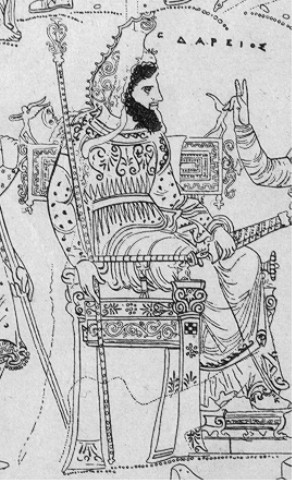 Darius I, imagined by a Greek painter, fourth century BCE Zoroaster teaches that there are two powers in the universe; Asha, which is truth, order, and that which is real, and Druj, which is "the Lie". Later on, the Lie became personified as Angra Mainyu, a figure similar to the Christian Devil, who was portrayed as the eternal opponent of Ahura Mazda (God). Herodotus, in his mid-fifth-century BC account of Persian residents of the Pontus, reports that Persian youths, from their fifth year to their twentieth year, were instructed in three things – "to ride a horse, to draw a bow, and to speak the Truth".[90] He further notes that:[90] "The most disgraceful thing in the world [the Persians] think, is to tell a lie; the next worst, to owe a debt: because, among other reasons, the debtor is obliged to tell lies." In Achaemenid Persia, the lie, drauga (in Avestan: druj), is considered to be a cardinal sin and it was punishable by death in some extreme cases. Tablets discovered by archaeologists in the 1930s [91] at the site of Persepolis give us adequate evidence about the love and veneration for the culture of truth during the Achaemenian period. These tablets contain the names of ordinary Persians, mainly traders and warehouse-keepers.[92] According to Stanley Insler of Yale University, as many as 72 names of officials and petty clerks found on these tablets contain the word truth.[93] Thus, says Insler, we have Artapana, protector of truth, Artakama, lover of truth, Artamanah, truth-minded, Artafarnah, possessing splendour of truth, Artazusta, delighting in truth, Artastuna, pillar of truth, Artafrida, prospering the truth, and Artahunara, having nobility of truth. It was Darius the Great who laid down the "ordinance of good regulations" during his reign. Darius' testimony about his constant battle against the Lie is found in the Behistun Inscription. He testifies:[94] "I was not a lie-follower, I was not a doer of wrong ... According to righteousness I conducted myself. Neither to the weak or to the powerful did I do wrong. The man who cooperated with my house, him I rewarded well; who so did injury, him I punished well." He asks Ahuramazda, God, to protect the country from "a (hostile) army, from famine, from the Lie".[95] Darius had his hands full dealing with large-scale rebellion which broke out throughout the empire. After fighting successfully with nine traitors in a year, Darius records his battles against them for posterity and tells us how it was the Lie that made them rebel against the empire. At the Behistun inscription, Darius says: "I smote them and took prisoner nine kings. One was Gaumata by name, a Magian; he lied; thus he said: I am Smerdis, the son of Cyrus ... One, Acina by name, an Elamite; he lied; thus he said: I am king in Elam ... One, Nidintu-Bel by name, a Babylonian; he lied; thus he said: I am Nebuchadnezzar, the son of Nabonidus. ... The Lie made them rebellious, so that these men deceived the people."[96] Then advice to his son Xerxes, who is to succeed him as the great king: "Thou who shalt be king hereafter, protect yourself vigorously from the Lie; the man who shall be a lie-follower, him do thou punish well, if thus thou shall think. May my country be secure!"[citation needed] |
ゾロアスター教 ギリシャの画家が想像したダレイオス1世(前4世紀) ゾロアスターは、宇宙には2つの力があると説いている。真理、秩序、実在するものであるアーシャと、「嘘」であるドルジである。その後、「嘘」はアング ラ・マインユとして擬人化され、キリスト教の悪魔に似た存在となり、アフラ・マズダ(神)の永遠の敵として描かれるようになった。 ヘロドトスは紀元前5世紀半ばのポントス地方のペルシャ人に関する記述の中で、ペルシャの若者たちは5歳から20歳まで3つのことを教えられたと報告して いる。 [90]彼はさらに次のように書いている:[90] 「(ペルシア人が)この世で最も恥ずべきことは嘘をつくことであり、次に悪いことは借金をすることである。 アケメネス朝ペルシャでは、嘘は大罪とされ、極端な場合には死刑に処せられた。1930年代に考古学者たちによってペルセポリス遺跡で発見された石版 [91]は、アケメネス朝時代の真実の文化に対する愛と崇敬について十分な証拠を与えてくれる。エール大学のスタンリー・インスラーによれば、これらの石 版に記された72人もの役人や小商人の名前に真理という言葉が含まれているという。 [93]このように、アルタパナは真理の保護者、アルタカマは真理の恋人、アルタマナは真理を愛する者、アルタファルナは真理の輝きを持つ者、アルタズス タは真理を喜ぶ者、アルタストゥナは真理の柱、アルタフリーダは真理を繁栄させる者、アルタフナラは真理の高貴さを持つ者である。 ダレイオス大王は、その治世において「良い規則の条例」を定めた。嘘との絶え間ない戦いについてのダリウスの証言は、ベヒストゥン碑文に見られる。彼は次 のように証言している[94]。「私は嘘に従う者ではなく、悪を行う者でもなかった。私は正義に従って身を処した。弱い者に対しても、強い者に対しても、 私は悪を行わなかった。私の家に協力する者には、私はよく報いた。 彼はアフラマズダ(神)に、「(敵対する)軍隊、飢饉、嘘から」この国を守ってくれるように頼んだ[95]。 ダレイオスは帝国全土で勃発した大規模な反乱に対処することで手一杯だった。ダレイオスは、1年間に9人の反逆者と戦い成功した後、後世のために彼らとの 戦いを記録し、彼らを帝国に反逆させたのがいかに嘘であったかを語っている。ベヒストゥンの碑文でダレイオスは言う:「私は彼らを打ち倒し、9人の王を捕 虜にした。一人はマギア人のガウマタで、彼は嘘をつき、こう言った: 私はキュロスの子スメルディスである。一人はアシーナという名のエラム人であった: 私はエラムの王だ.一人、名はニディントゥ=ベル、バビロニア人、彼は嘘をつき、こう言った: 私はネブカドネザル、ナボニドゥスの息子である。... その嘘が彼らを反抗させたので、この者たちは民を欺いた」[96] そして、彼の後を継いで大王となる息子のクセルクセスに忠告した: 「汝、今後王になる者は、嘘から身を守れ。嘘に従う者は、汝がそう考えるならば、汝は彼を罰するがよい。我が国が安泰でありますように!」[要出典]。 |
| Appeal to emotion Black propaganda Ethics Fabrication (science) False analogy False equivalence Falsifiability Knowledge falsification Mental reservation Plausible deniability Post-truth politics Preference falsification Prisoner's dilemma Psychological manipulation Sophistry Spin (public relations) |
感情に訴える ブラック・プロパガンダ 倫理 捏造(科学) 誤った類推 誤った同等性 偽造可能性 知識の改竄 精神的予約 もっともらしい否認可能性 ポスト真実政治 選好の改竄 囚人のジレンマ 心理操作 詭弁 スピン(広報) |
| https://en.wikipedia.org/wiki/Lie |
|
リ ンク
文 献
そ の他の情報
Copyleft, CC, Mitzub'ixi Quq Chi'j, 1996-2099
☆
 ☆
☆